
Do you visit Bayonne France and the Basque Country soon? Read this article where you will find the best itinerary to discover the romantic French town of Bayonne or “Grand Bayonne”.
The French city of Bayonne ham, classified as a city of art and history (1), is indeed made up of 3 main districts in the center: Petit Bayonne, Grand Bayonne, and the Saint Esprit district, or railway station district. It is definitely one of the most romantic French cities with its roman and medieval ruins, its canals and stilt houses.
Old Bayonne, the historical center and the Roman castrum dating from the 5th century, is actually called “Grand Bayonne”.
Each district of downtown Bayonne will be the subject of a separate article.
Article updated on 17 August 2022.

In this article you will find:
- the best itinerary to visit Old Bayonne in France.
- where to park.
- where to eat.
- a viewpoint outside of Old Bayonne to photograph the bridges and quays.
- a video with the 9 stops.
- a FAQ.
- Some additional resources.
Are you looking for recommendations for visits, accommodations, restaurants, activities?
Sign up for the newsletter by clicking here and receive all my tips and tricks.
Where to park to visit Bayonne France?
The ideal is to park in one of the large parking lots on the Paulmy alleys. The first hour is free. After that, it’s 1€ for 4 hours.
It is a perfect place to start this loop without having to retrace your steps; and the tourist office is nearby.
1. The botanical garden and the site of the poterne.
If you visit Bayonne between mid-April and mid-October, don’t miss the botanical garden.
From the Champ de Foire parking lot, head towards the ramparts and the city. You will soon come to an old medieval gate, where you can still see the drawbridge mechanism. Turn left just after. Walk along the ramparts until you reach the Poterne. If the garden is open, you can see its raised entrance on the far left.
The botanical garden, or rampart garden, was created in an area of 3,000m2, previously overgrown with brambles.
As its name indicates, it was built on a bastion of the ramparts, improved by Vauban from 1680 (2).
Made with recycled materials, it nicely mixes Basque and Japanese cultures.
It is divided into several sectors and houses a permanent exhibition.

Even if the garden is closed, don’t miss the Parc de la Poterne and the Porte de la Poterne (3), outside the garden, and therefore accessible at all times. Stroll inside the ramparts as well.
Booking.com2. Château Vieux, the town hall and the chocolate makers.
Pass under the Poterne and go around the Château-Vieux by the allée de la Poterne.
Château Vieux (4), built in the 12th century during the English tutelage, is an ancient house of the Viscounts of Lapurdi, the family of Sault. The northwestern part integrates the towers of the old Roman enclosure.
Turn left at the corner of Château Vieux.
Notice on your left the nice pedestrian layout of the Place and the Galeries Lafayette.
Continue on Rue Thiers until you reach the town hall. If you need a bathroom break, turn left towards the parking lot. You will find a public toilet on the right, just after the parking lot. Otherwise, turn right.
Admire the façade of the town hall overlooking the Place de la Liberté. It is from this square that the people of Bayonne witness the awakening of King Léon every morning during Bayonne Fests. Take the time to admire the square, step back to take pictures of the facade. Turn around to see the citadel, a little higher, the beautiful tower of the station, the watchtower and the Mayou bridge, the quays.
Go back on your steps and take the Rue Port-Neuf.
Rue Port-Neuf is also known as the street of chocolate makers, since you will find there several of the chocolate makers of Bayonne: the magnificent Cazenave tea room, where you can taste their famous sparkling chocolate, the chocolate maker Daranatz, l’Atelier du Chocolat; but also the Maison Pariès with its famous kanougas and muxus. This street comes alive even more during Bayonne chocolate festival. You can see the traces of its past as a waterway until the 17th century, through its architecture with arcades and on stilts. Admire the beautiful half-timberings and painted shutters.
Read More: Choose your travel dates according to these 100+ traditional Basque festivals
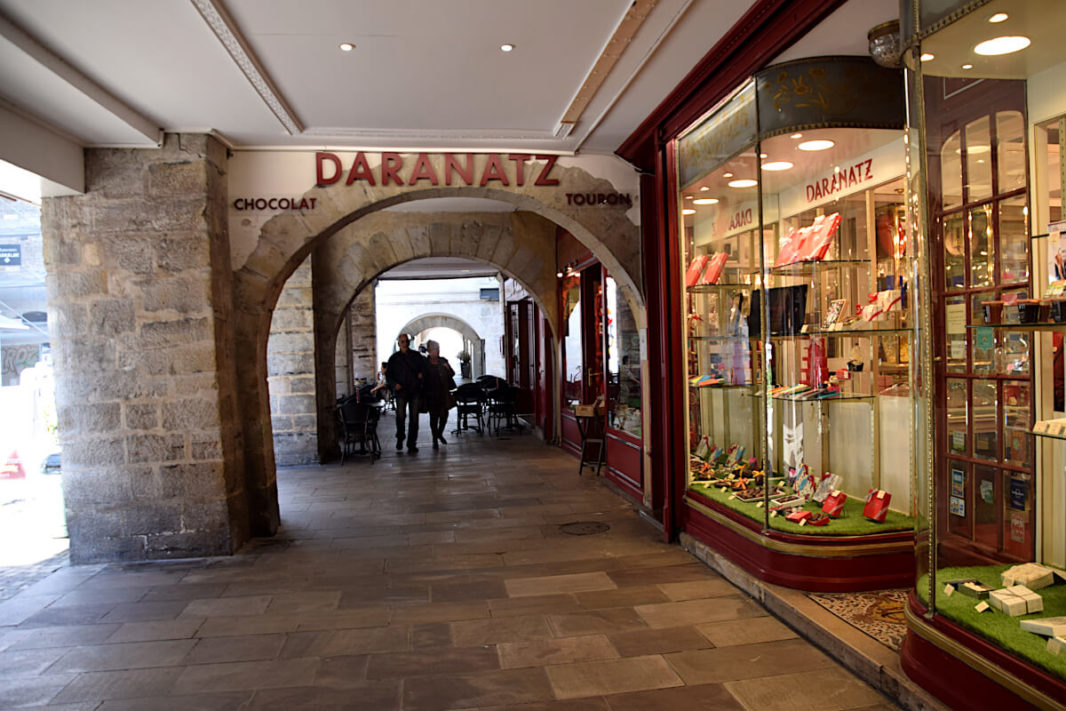
3. Bayonne cathedral and its cloister.
Continue on the Rue de la Monnaie. Admire the Hôtel de la Monnaie and the beautiful facades, especially on the square. Go around to the left to find the entrance to the cloister.
Visit the cathedral and its cloister.
Read this article to know more about the cathedral, its history and see pics

Go out through the main entrance and admire the porch, with many elements of Basque culture. Then go around the cathedral to the left. Note where is one of the restaurants mentioned below, Le Pavé, Rue des Gouverneurs. And there are public toilets next to the media library.
Stroll through the pretty streets – Rue des Prébendes and Rue de Luc – and their pretty stores. Take a look at the views of the cloister, more mysterious than when you walk through it.
4. Pillory and Bayonne market halls.
Go to the fountain of the pillory.
In the Middle Ages, women of ill-repute were exposed in a wooden cage and scorned, stones were thrown at them and they were spat on. They were then taken to the Nive at low tide and the river was finishing the job…
Go down to the Nive by the Rue du Pilori.
You arrive at the Carreau des Halles. From here and as you approach the quay, you have beautiful views of Petit Bayonne, the Basque Museum, the citadel, the market halls, the Maison Moulis, the bridges and the Royal Bastion.

Enjoy the market (every morning until 1:30 pm Monday through Thursday, 2:30 pm on Friday, Saturday and Sunday). If you come on a Saturday morning, take the time to stroll through the farmers’ market on Quai Chaho and Rue Pelletier. You will find craftsmen and merchants.
5. Moulis House and Aubard Ham Museum.
You can’t miss the beautiful Moulis shipowner’s house, at the corner between Quai Jaureguiberry and Rue Poissonnerie. Renaissance style but remodeled in the 19th century, it was repainted in 2018.
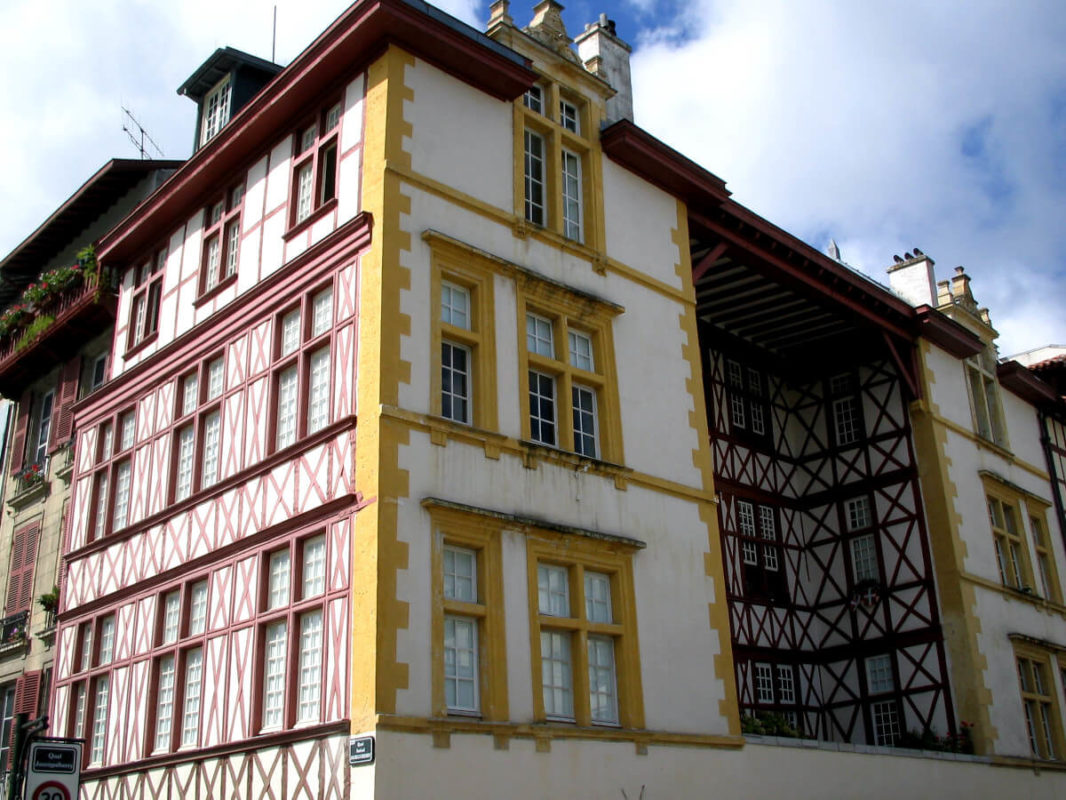
Take the Rue Poissonnerie.
Visit the Aubard Ham Museum.
6. Rue des Basques, Tour Saint Simon and a viewpoint to photograph the bridges.
Leaving the Museum of Ham, take the splendid and typical Rue des Basques opposite.
The name of this street reminds us that the city is not Basque but Gasconne!
At the end of the street, on the right, you will find the Tour Saint Simon. Ignore it for the moment and turn left to admire the Tour de Sault.
The Tour de Sault, from the 12th century, was built in front of the Roman enclosure to reinforce the defense of the river port. It supports a chain connected to the opposite Tower of Menons, allowing to close the river to navigation if necessary.
If you want to take a nice picture of the bridges and the quays, go to the Bastion Royal, on the other side of the Nive, so in Petit Bayonne. Take advantage of its viewpoint at the top to photograph the quays and bridges.
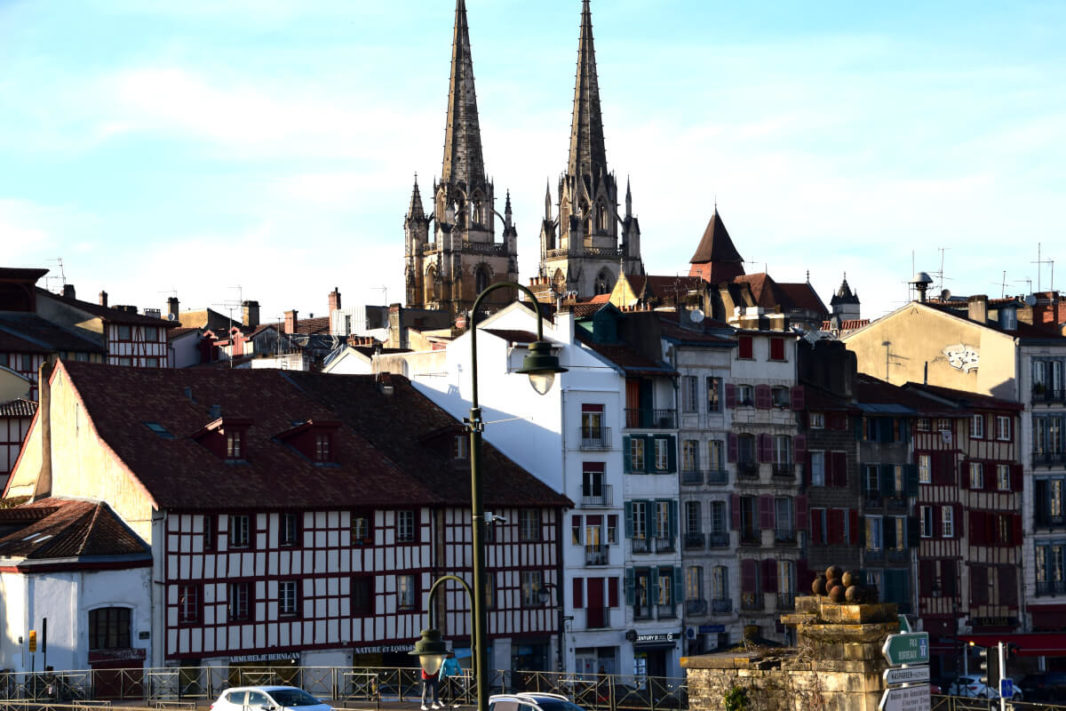
Go back on your steps and the Saint Simon Tower.
The Saint Simon Tower is a vestige of the door pierced in the enclosure in the 12th century, separating from the cagots or lepers’ district.
7. Plachotte and Rue des Augustins.
Behind the tower, take the passage des Cacolets.
The cacolets were wicker baskets used to transport travelers on donkeys or mules, before the construction of a carriageway between Bayonne, Anglet and Biarritz. They were then used for tourists.

You arrive at La Plachotte, Rue des Augustins. Admire the typical houses of the Plachotte and have a look at the pretty houses of the Rue Passemillon, on the left. Continue in the direction of the Tour de la Plachotte and the Luna Negra.
8. Rue and Porte d’Espagne.
Turn left into Rue Poissonnerie, which you follow until you reach Rue d’Espagne. Turn left again to take the Rue d’Espagne, pedestrian and paved, to the ramparts.
Notice the facades with two windows with wrought iron balconies, the half-timbering and the knocking doors. Some of the houses have a historical sign, explaining their purpose according to the periods.
Cross over to the Porte d’Espagne and the Casemate Saint Léon.
The Spanish Tower has been the southern entrance to the city since the 4th century (foundation of the Roman Castrum). In the Middle Ages, a barbican was added to it, then a drawbridge and casemates in the 17th century, before the last reorganization by Vauban.
Booking.com9. Tour Vieille-Boucherie and district of the craftsmen and trades of art.
Continue on the Boulevard du Rempart Lachepaillet to the Tour Vieille-Boucherie (signposted to the cathedral) and pass under the Roman fortification wall.
Also known as the Roman Tower and contrary to what its name suggests, the Vieille-Boucherie Tower does not face directly onto Rue Vieille-Boucherie.
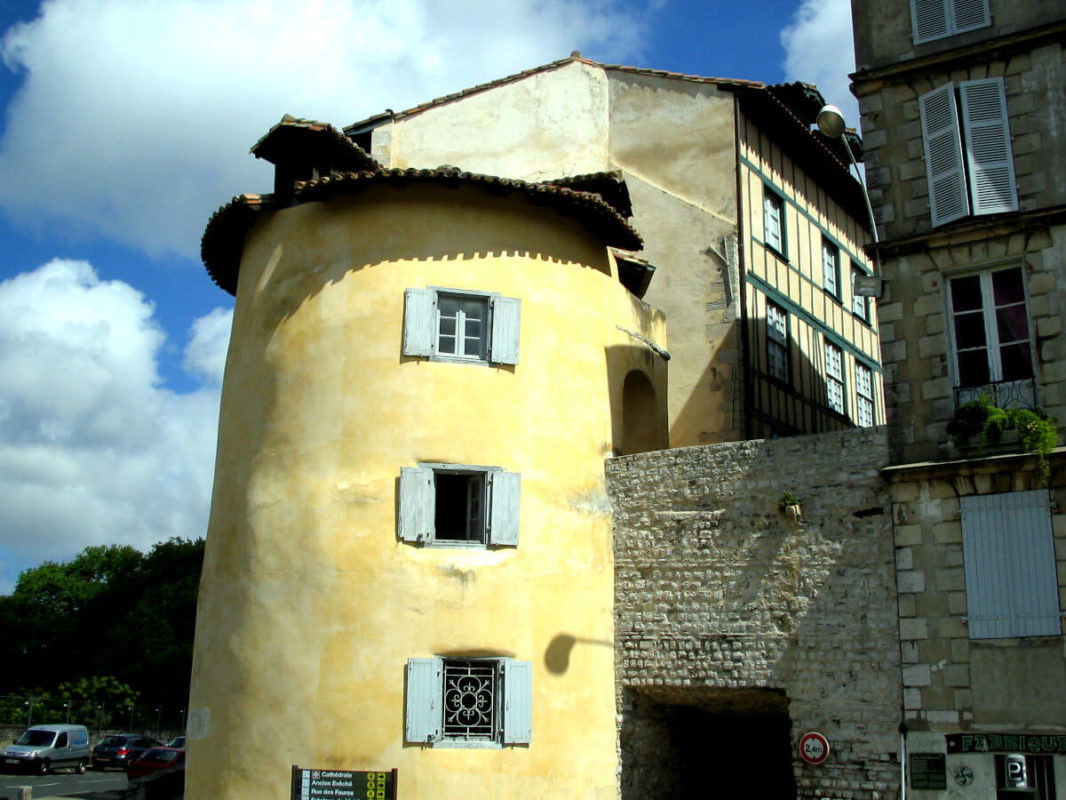
Admire the facades of the old houses. At the intersection of Rue Vieille-Boucherie and Rue Douer, don’t miss the makila factory (walking stick doubled with a weapon) and the wheel on a façade on Rue Douer.
Go to the Place Emile Boeswillwald, which you cross.
A student of Viollet Le Duc, Boeswillwald built the spires of the cathedral of Bayonne.
Cross the Place Montaut and turn left into the Rue Douer to return to what used to be called the “quartier des antiquaires artisans métiers d’art”, Rue des Faures.
At the end of the street, turn left to go back along the ramparts and return to the parking lot.
Video of the itinerary in the Grand Bayonne France.
Where to eat in Grand Bayonne or Petit Bayonne?
Here are 4 addresses that I really like, to choose according to your needs:
- My little warung, Quai des Corsaires, next to the Basque Museum, for an Asian dish on the go.
- La Rôtisserie du Roy Léon, 8 rue de Coursic in Petit Bayonne, in the evening for a hearty and traditional Gascony menu.
- Patxamama, 7 rue Port de Castets in Old Bayonne, for its cuisine of local products and its local dishes in a room with exposed stones. But also and above all for the skill of the Chef, Nicolas Bouchard, to assemble local products in an explosion of flavor. I still salivate at the thought of the mushroom-like meal he concocted for Slow Food association dinner!
- At the market, in or around the market halls.
Private tour guide Bayonne and Basque Country.
If you are looking for a private English tour guide in Bayonne and/or Basque Country, contact me!
I will take you around Bayonne and other nearby places, according to your needs and schedule.
You can fill the form here, so I will know your needs and will contact you.
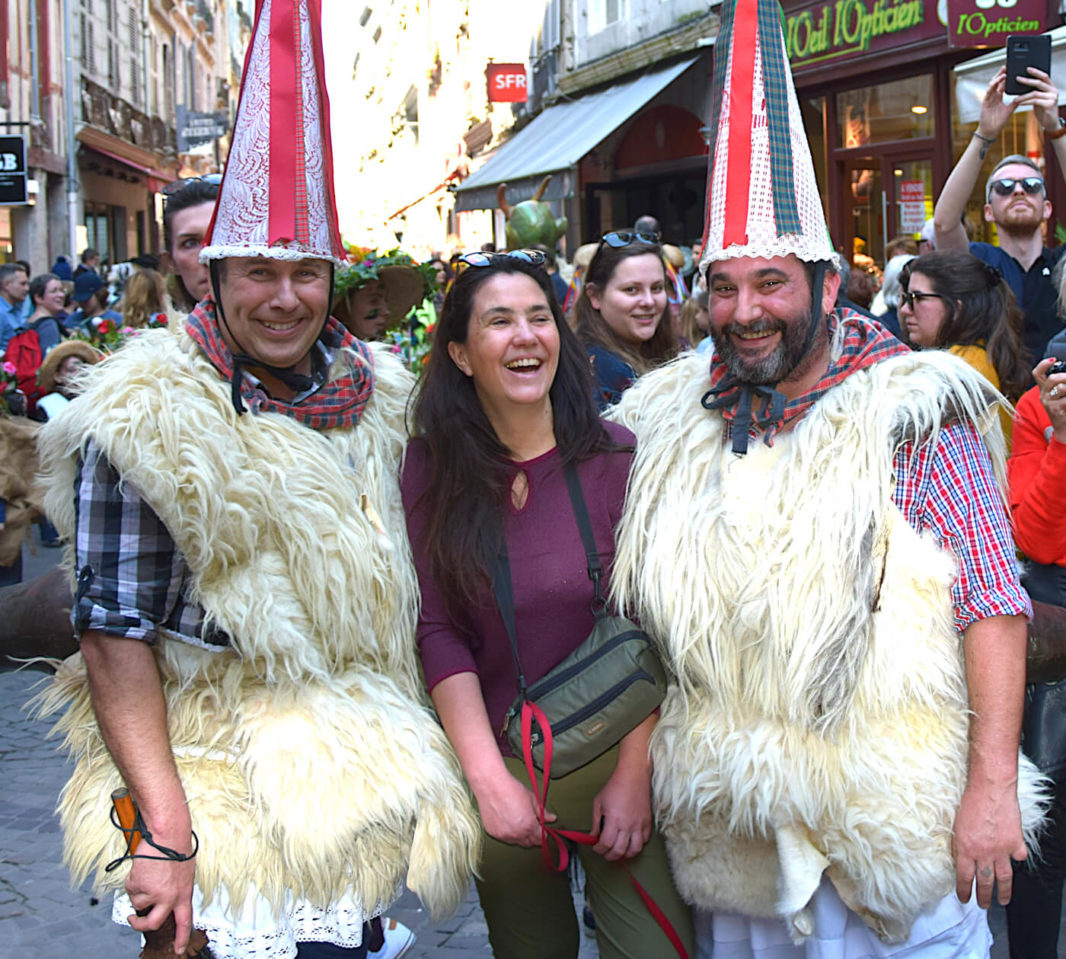
See How I Can Help You Organize Your Tour
Help with the preparation of the tour
Connection with my local contacts
Guiding your group in French or English
How to go to Bayonne France?
TGV trains connect Paris to the Basque Coast, via Saint Pierre des Corps, Poitiers and Bordeaux.
The nearest airport is Biarritz Pays Basque airport.
The cities of Bayonne, Anglet and Biarritz touch each other. This area is called the BAB. There is a bus and tramway service within the BAB, but also to and from Tarnos, Saint Jean de Luz, Saint Jean Pied de Port, etc. You can also take the TER from Biarritz, Saint Jean de Luz, Hendaye, Guéthary, Pau, Orthez, Puyoô, Peyrehorade, Saint Jean Pied de Port and the small intermediate stations (often provided by bus). Intercity trains provide connections to Pau, Tarbes and Toulouse.
To go further, read my Biarritz travel guide here
Distance Bayonne Paris.
Bayonne is located 770kms from Paris. The TGV now makes the connection in about 4h30.
Distance Bayonne Spain.
Bayonne is 58kms from San Sebastian and 156kms from Bilbao.
Bayonne Spain routes.
If you are in a hurry, you can take the highway. However, I recommend you to take the beautiful coastal road, especially the road of the cornice of Urrugne, between Saint Jean Pied de Port and Hendaye.
Distance Bayonne Lourdes.
Lourdes is 147kms from Bayonne. Even the journey by highway is very beautiful with views of the Pyrenees.
Intercity trains from Bayonne to Tarbes serve the Lourdes station.
Distance Bayonne Espelette.
Espelette is located 26kms from Bayonne, inland.
Buses leave from the Place des Basques to Espelette and make the trip in about 1 hour.
Bayonne Saint Jean Pied De Port.
TER trains run between Bayonne and Saint Jean Pied de Port, via Cambo les Bains, in 1h17.
Frequently asked questions on Bayonne.
– If you want to walk around Bayonne, you can do so in the Grand Bayonne, the historic district. Check out my tour itinerary here.
– Stroll around the ramparts.
– Enjoy the typical streets of Petit Bayonne.
– Go to the Saint Esprit district to see the bridge and visit the synagogue.
– Visit the citadel.
– Stroll along the Adour and Nive rivers.
– Walk along the Port-Neuf street and taste chocolate.
– Visit the Bayonne ham salting workshop and enjoy a free tasting.
The Bayonne market, in the halles, takes place every day in the morning and you can buy fresh products there.
There is a fish market, every morning except Sunday, on the Allées Marines (direct sale).
Open-air markets are held in different places during the week. The most interesting is the local producers’ market on Saturday mornings around the halles.
You can easily visit Bayonne on foot. English guided tours are offered by independent guides.
Bayonne is pronounced like the famous Angkor temple “Bayon”!
Bayonne was the first French city where chocolate was introduced. Jews fleeing the Inquisition settled in Bayonne, in the Saint Esprit district, and set up their cocoa-processing shops across the bridge, in the Grand Bayonne area.
Bayonne can be visited in any season. The time of the end of year celebrations is nice for the animations and illuminations. The period of the Bayonne carnival, in February, is also interesting for all the carnivals in the surroundings, especially in Navarre. In April, it is the ham fair and the Holy Week in nearby Spain. The Basque Country is lively all year round, not only in summer.
The name Bayonne is a contraction of the Basque words Ibai (river) and Ona (good).
Hotels Bayonne
Okko Hotel Bayonne.
This 4* hotel, very recent and modern, is located at the end of the Boulevard du BAB, on the Bayonne side.
It is located about 700 meters from the city center, near the Pont Grenet, and overlooks the Adour. From its club terrace, you can enjoy a beautiful view of the river, the city and the Pyrenees.
You can come by train, the station being very close, and then visit the center of Bayonne on foot. You can also easily go to Biarritz, Saint Jean de Luz, Hendaye, etc. by bus or train.
If you come by car, the underground parking costs 16€; but you will be able to find cheaper or even free parking in the area.
Click here to check availability and price
Campanile Bayonne.
A personal vehicle is essential if you wish to stay at the Campanile of Bayonne, located 5 minutes from the center by car, in the direction of the Landes and Bearn, on the Avenue du Grand Basque.
Première Classe.
Located in the same area of the Grand Basque as the Campanile, you will also need your own vehicle.
Click here to check availability
Les Genêts.
Located at the Rond-Point of Maignon, 1.5kms from the A63 and 3.6kms from downtown, in a commercial area.
Villa Koegui.
Hotel Villa Koegui is located in the heart of Bayonne, a stone’s throw from the Place du Réduit, between the Adour and Nive rivers.
The train station and points of interest in the historic center are within walking distance, so you won’t need a car to visit the city and the surrounding area, which is connected by public transportation.
Click here to check availability and book
Hotel Loreak.
You will need your own vehicle if you wish to stay at this hotel, also located near the Rond-Point du Grand Basque.
Conclusion – How to Visit Bayonne France.
You now have the perfect itinerary to discover Old Bayonne and its Roman and medieval remains.
Of course, don’t hesitate to stroll further. You will find other interesting towers on the Boulevard des Remparts, and other typical houses in the vicinity of the streets surveyed on this route.
You can also take the opportunity to visit Petit Bayonne at the same time.
Have you already visited Bayonne? Do you have any other tips or favorites to share? Do you have any questions? Don’t hesitate to share them with us in comments.
For more articles about the Basque Country, click here
Share this article with your family or friends who are planning their next trip to the South of France.
Products and services.
Stay with us in the South of Landes
Tour with me in the Basque Country
Rick Steves – Basque Country Travel Guide
Bayonne tourism information office
Booking.comThis article contains compensated links. As an Amazon Associate I earn from qualifying purchases. Consult the disclaimer on the site for more information.
Notes and References.
- City and Country of art and History Label – Ministère de la Culture
- Vauban Site – Bayonne
- Geocaching – Porte de la Poterne
- Monumentum – Château Vieux
